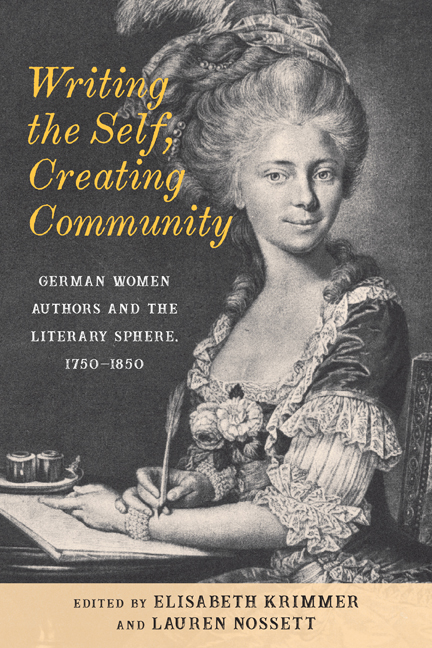Book contents
- Frontmatter
- Contents
- Acknowledgments
- Introduction
- Part I Writing a Community
- 1 Empowering Germany’s Daughters: On the Pedagogical Program and the Poetic Techniques of Sophie von La Roche
- 2 “Ich spreche lieber von guten Büchern”: Sophie von La Roche’s Concept of Female Authorship and Readership
- 3 Challenging Female Ideals: Marie-Elisabeth de La Fite’s Translation of Sophie von La Roche’s Geschichte des Fräuleins von Sternheim
- 4 Catherine II, Polyxene Büsching, and Johanna Charlotte Unzer: A Literary “Community of Practice”
- Part II Writing the Self
- 5 Ghostwriters: The Apparitional Author in Benedikte Naubert’s “Die Weiße Frau” (1792) and Sophie Albrecht’s Das Höfliche Gespenst (1797)
- 6 Vampirism Inverted: Pathology, Gender, and Authorship in Karoline von Günderrode’s “Die Bande der Liebe”
- 7 Wozu eine Amazonen—Literatur? Literary Creativity and Productivity in the Writings of Helmina von Chézy
- 8 Women Writers and the Märchenoma: Foremother, Identity, and Legacy
- Part III Writing toward Emancipation
- 9 The Illegitimacy of Authorship and the Legitimization of Passion in Agnes von Lilien
- 10 The Politics of the Female Body in Louise Aston’s and Fanny Lewald’s Writings through the Prism of the Romantic Theory of Sociability and Dialogue
- 11 Weibliche Irrsterne: Louise Otto and the Notion of Female Genius in Nineteenth-Century Germany
- Bibliography
- Notes on the Contributors
- Index
8 - Women Writers and the Märchenoma: Foremother, Identity, and Legacy
Published online by Cambridge University Press: 01 October 2020
- Frontmatter
- Contents
- Acknowledgments
- Introduction
- Part I Writing a Community
- 1 Empowering Germany’s Daughters: On the Pedagogical Program and the Poetic Techniques of Sophie von La Roche
- 2 “Ich spreche lieber von guten Büchern”: Sophie von La Roche’s Concept of Female Authorship and Readership
- 3 Challenging Female Ideals: Marie-Elisabeth de La Fite’s Translation of Sophie von La Roche’s Geschichte des Fräuleins von Sternheim
- 4 Catherine II, Polyxene Büsching, and Johanna Charlotte Unzer: A Literary “Community of Practice”
- Part II Writing the Self
- 5 Ghostwriters: The Apparitional Author in Benedikte Naubert’s “Die Weiße Frau” (1792) and Sophie Albrecht’s Das Höfliche Gespenst (1797)
- 6 Vampirism Inverted: Pathology, Gender, and Authorship in Karoline von Günderrode’s “Die Bande der Liebe”
- 7 Wozu eine Amazonen—Literatur? Literary Creativity and Productivity in the Writings of Helmina von Chézy
- 8 Women Writers and the Märchenoma: Foremother, Identity, and Legacy
- Part III Writing toward Emancipation
- 9 The Illegitimacy of Authorship and the Legitimization of Passion in Agnes von Lilien
- 10 The Politics of the Female Body in Louise Aston’s and Fanny Lewald’s Writings through the Prism of the Romantic Theory of Sociability and Dialogue
- 11 Weibliche Irrsterne: Louise Otto and the Notion of Female Genius in Nineteenth-Century Germany
- Bibliography
- Notes on the Contributors
- Index
Summary
“GUTE, FROHE WEIBER UND MÄDCHEN, blättert sie immerhin durch!” (“Good and cheerful women and girls, page through this book!”) reads the inviting introduction to the anonymous 1801 Feen-Mährchen: Zur Unterhaltung für Freunde und Freundinnen der Feenwelt (Tales of Fairies: For the Entertainment of Male and Female Friends of the Fairy- World). This introduction frames its audience and its source, an old, fairy-tale-telling aunt, as female. Since both female authorship and female readership were growing in the nineteenth century, such a call seems warranted. In the same time period, Jacob and Wilhelm Grimm, and later in the century Ludwig Bechstein, were gathering oral tales from mostly female sources but rarely giving these storytellers proper credit. As the nineteenth century went on, more than four hundred women would pen fairy tales, and the number of women writers would grow exponentially.2 While fairy-tale-telling women, known informally as Märchenomas—literally, fairy-tale grandmas—would be praised by the Grimms and others, women writers were often vilified. To women writers, however, the Märchenoma and the Autorin (female author) were often not so different. 3 Benedikte Naubert's 1789 Neue Volksmärchen der Deutschen (New Folktales of the Germans), the 1801 Feen-Mährchen by an anonymous author who is presumed to be female, and Karoline Stahl's 1818 Fabeln, Mährchen, und Erzählungen für Kinder (Fables, Fairy Tales, and Stories for Children) reflect an approach to folklore and the tradition of female storytelling that is very different from that of the Brothers Grimm. These female authors saw the Märchenomas in their lives and the early French fairy-tale author Marie-Catherin d’Aulnoy as their foremothers. In some cases, they themselves embraced the identity of a Märchenoma. Moreover, their texts included representations of storytelling, mentoring, and fellowship by and among women. In this way, they overcame the stigma and challenges facing women writers of this period.
Feminist scholars have demonstrated how eighteenth- and nineteenth- century women writers struggled to find mentors and models, to craft an identity that would allow them to be both feminine and creative, and to identify a tradition that would give context to their careers. Sandra Gilbert and Susan Gubar's landmark The Madwoman in the Attic (1979) discusses the challenges facing nineteenth-century British women writers, and Ruth-Ellen Boetcher Joeres's Respectability and Deviance (1998) addresses the unique situation of German women writers.
- Type
- Chapter
- Information
- Writing the Self, Creating CommunityGerman Women Authors and the Literary Sphere, 1750–1850, pp. 179 - 200Publisher: Boydell & BrewerPrint publication year: 2020



